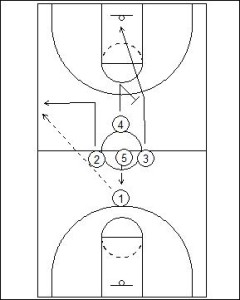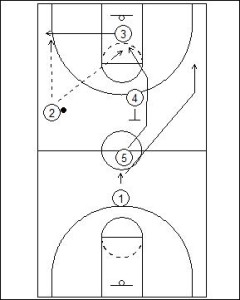Jump Ball: Screen Back (Defensive Tip)
A Jump Ball might only happen once a game but it still should produce some sort of offense for a team. Many teams will never practice a jump ball play and just be happy to “have a go”. For this reason, a team that does practice the jump-ball situation can usually derive some scoring opportunities if for no other reason than the element of surprise.
A Defensive Tip is a jump ball scenario where a team feels they are not a good chance to winning the contest so the strategy is to tap the ball back to a player standing long. Just because the term “Defensive” is mentioned does not mean there is a reluctance to try to score, rather that securing possession is the first goal of the situation and then scoring.
The Jump Ball Screen Back Play looks to spread the ball and then use a screening action to send multiple players to the basket quickly while the defence is in motion hopefully resulting in a scoring opportunity.

Because this is a defensive tip players overload the defensive side of the jump circle. One (1) moves back towards the basket and goal here is for the tip to be pushed over the head of the opposition player to the Point Guard standing long.
Once the tap is secured by One (1), Two (2) makes and an aggressive L-Cut to finish in line with the top of the three-point line on the sideline. This position makes a pass from One (1) easier and creates width on the floor which should assist Two (2) in being able to gain some space and see better the opportunities as they are presented.
Four (4) dives hard towards the basket, but when the player reaches the top of the keyway they will turn and lift to set a screen for Three (3). The screen needs to be positioned to the weak side of the split line so once Three (3) comes over the screen the defender will have no chance of moving between the passer (Two) and Three as the cutter dives to the basket. In most situations this will result in Three’s defender trailing the player and is a very good situation for the offensive team.
The timing here will be very tight as Four (4) and Three (3) at the jump ball will only be separated by a few feet. It is important though for this screen to happen at pace to provide the most beneficial situation for Three (3) in cutting to the basket.
If the pass is to be made by Two (2) to Three (3) it must be out in front of the offensive player. If the pass is even slightly behind the player this will allow the defender to attempt a deflection or steal the ball. If the pass is too long it will force the offensive player to over extend and make a poor shot off balance and out of control.

Following Three (3) reaching the basket if no scoring pass is made the following sequence occurs.
Three (3) continues cut to strong side long corner. This is an important movement as this shifts Three’s (3) defender out of the key and the targeted passing area.
Two (2) has an option of passing down the side line to Three (3) for a better passing angle.
Four (4) lifts from the screening position initiated for Three (3) and re-sets a screen for Five (5) who was involved in the initial jump ball contest.
Five (5) can go around either side of the screen and this will really depend on the positioning of the defender and the initial movement of this defensive player following the jump ball.
Following the screen, Five (5) cuts to the basket looking for the pass from either Two (2) or Three (3) depending on who now has the ball.
One (1) moves up the floor following the pass and can either finish in the Point Position or move to the weak side of the floor to help spread the defensive players move evenly.
If the defensive team regularly fronts players then it is suggested that One (1) move to the weak side of the floor as this will allow a quick skip pass to be executed and a pass made into Five (5) on the basket who can hold a seal and keep the defender on their back.







